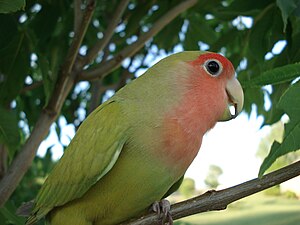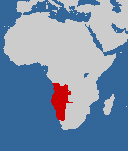Rose-headed
| Rose-headed | ||||||||||||
|---|---|---|---|---|---|---|---|---|---|---|---|---|

Rose-headed rose ( Agapornis roseicollis ) |
||||||||||||
| Systematics | ||||||||||||
|
||||||||||||
| Scientific name | ||||||||||||
| Agapornis roseicollis | ||||||||||||
| ( Vieillot , 1818) |
The Rosenköpfchen ( Agapornis roseicollis ) is a kind of the genus of Unzertrennlichen . Together with the other species of this genus, as well as the gray parrot , the long wing parrots , the Rose-ringed Parakeet and Madagascar endemic Vasa Parrots this type is a typical parrot species of Afrotropical .
description
The body length of the rose head is about 15 cm, it weighs 46 to 63 g when fully grown. The sexes cannot be distinguished on the plumage. The basic color of the body is a pastel green. The face, cheeks and throat are colored salmon pink up to the front breast. The upper tail-coverts as well as the rump stand out from the rest of the plumage by their bright blue color. The beak of the rose-head is horn-colored, the iris is dark brown.
Rose heads now exist as color mutations in many colors. There are hardly any pure roseicollis left . The youth dress has a faded and paler pink and green.
distribution and habitat
The distribution area of the rose-head is southwest Africa, from the northern Cape Province of South Africa via Namibia (known there as the rose parrot ) and Botswana to Angola . In the north-west of Angola and southern Luanda the species was introduced in Quiçama National Park, as well as overgrown populations in North American Arizona near Phoenix and Tucson .
It occurs at heights of up to 1500 m and inhabits mainly dry forest areas or semi-deserts, steppes and savannas with sparse trees. The edges of forests and rivers, as well as areas near arable land, are also inhabited.
Lifestyle and diet
It inhabits the African arid areas in small groups of 5 to 20 birds. Wherever there is an abundant supply of food or a source of water, swarms of hundreds of individuals can gather. They are rather incompatible with other bird species.
The diet consists mainly of seeds of grass, sunflower seeds, millet and corn. In some areas they also specialize in mouse hunting.
Reproduction
Similar to the mountain parrots belonging to the same genus, the rose-headed parrots also use an unusual method of carrying the nesting material to the breeding site: They transport branches, bark and other parts of plants by clamping them in the plumage. While peach heads , black heads and strawberry heads build a goblet-shaped, closed nest with a side entrance, the rose-head only builds a cup-shaped base. They usually create their nests in crevices in the rock, often together with the settlement sparrow , or under the roofs of low houses.
In the breeding season from February to March and from April to October four to six eggs are usually laid, which are then incubated by the female alone for about 21 to 23 days. During the brood this is taken care of by the male. After another five to six weeks, the young are fledged. A further 14 days later they are then self-employed.
Utterance
Their screams sound shrill and metallic and are often repeated. If you are nervous, the frequency of the screams increases.
Subspecies
The following subspecies are known:
- Agapornis roseicollis roseicollis ( Vieillot , 1818) - nominate form
- Agapornis roseicollis catumbella B. P. Hall , 1952 - mainly inhabits southwest Angola and the Quicama National Park. The red of the cheeks is darker in this subspecies.
literature
- Rosemary Low: The Parrot Book. Ulmer Verlag , Stuttgart 1989, ISBN 3-8001-7191-0 .
- Werner Lantermann : parrot science. Parey Buchverlag, Berlin 1999, ISBN 3-8263-3174-5 .
- Hans-Detlef Mebes: Behavioral studies on the rose parrot (Agapornis roseicollis) in the laboratory and in southwest Africa. In: Meeting reports of the Society of Friends of Natural Sciences in Berlin (NF). Volume 23, 1983, pp. 58-66.
- Georg A. Radtke : Inseparable (agapornids): keeping, breeding and color variations. Franckh, Stuttgart 1981, ISBN 3-440-04947-7 , pp. 37-47.
Individual evidence
- ↑ Agapornis roseicollis. Namibia Biodiversity Database. Retrieved February 14, 2020.
- ↑ Low, p. 179.
- ↑ a b c Urania animal kingdom birds. Volume 2, p. 238.
- ↑ Lantermann, p. 461.
- ^ ITIS Report , accessed on February 14, 2010.
Web links
- World Parrot Trust , accessed February 14, 2010.
- Videos, photos and sound recordings on Agapornis roseicollis in the Internet Bird Collection , accessed on February 14, 2010.
- Youngling rosebuds. Photos every day of growth. , accessed February 14, 2010.
- Agapornis roseicollis inthe IUCN 2013 Red List of Threatened Species . Listed by: BirdLife International, 2012. Retrieved December 26, 2013.



